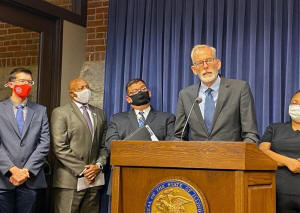Report details community colleges’ impact on economy, earnings
 Send a link to a friend
Send a link to a friend
[September 30, 2021]
By JERRY NOWICKI
Capitol News Illinois
jnowicki@capitolnewsillinois.com
 SPRINGFIELD – Illinois community colleges
have a multi-billion dollar impact on the state’s economy and will be
“integral in making a recovery from the pandemic an equitable one,”
according a new report from the Northern Illinois University Center for
Governmental Studies. SPRINGFIELD – Illinois community colleges
have a multi-billion dollar impact on the state’s economy and will be
“integral in making a recovery from the pandemic an equitable one,”
according a new report from the Northern Illinois University Center for
Governmental Studies.
The Illinois Community Colleges’ Economic Impacts and Student Employment
Outcomes report said the indirect economic output tied to community
colleges in 2020 was $3.5 billion. Directly, the state’s 48 community
colleges employed 32,867 individuals in 2020 at a total combined salary
of $1.3 billion.
Lazaro Lopez, chair of the Illinois Community College Board, said at a
news conference unveiling the study that it proves what an economic
force the state’s community college system is.

“As the largest workforce training provider in Illinois, community
colleges create an educated and skilled workforce that addresses current
and future needs of many critical industries throughout our state,” he
said. “And through this work, community colleges provide a substantial
economic benefit for the state and local communities where they reside.”
An investment in a completed associate degree is worth $238,000,
according to the report, meaning someone completing a degree can expect
to earn that much more over 40 years than if they did not.
“The internal rate of return on their investment is 26.8 percent,”
according to the study. “In other words, if a student put $33,368 in an
investment that returned 40 annual payments equivalent to the earnings
gains from an associate degree, they would earn interest at a rate of
26.9 percent.”
That’s factoring in an assumed cost of $31,883 for the degree, including
tuition and other expenses as well as “opportunity” cost, which includes
time spent at school instead of work.
Brian Richard, one of the study’s authors from NIU’s Center for
Governmental Studies, said the report is based on actual earnings of
graduates, rather than just national averages.

“Something unique about this is we attached, connected, actual students’
records with actual wage records, so the numbers in this study reflect
the reality of what those students experienced in the workforce, not
just some estimates based on national averages and things,” he said at
the news conference. “The numbers reflect the true experience of those
students that have graduated over the past 10 years or so.”
A degree or even a short-term, narrow certificate can lead to higher
wages and more likely long-term employment, said Brian Durham, executive
director of the ICCB.
“More than 84 percent of graduates with a long-term certificate or an
(associate of applied science degree) are employed in jobs in their
chosen career field within a year of graduation,” he said. “And five
years after graduation, graduates with an associate's degree who then
transfer to a four-year institution have employment rates of 85
percent.”
[to top of second column]
|

Brian Richard, of the Northern Illinois University
Center for Governmental Studies, is pictured at a news conference at
the Illinois State Capitol. He is the author of a report showing the
economic impact of community colleges. (Capitol News Illinois photo
by Jerry Nowicki)

For those that earn short-term certificates, Durham
said electrical and power transmission installers can earn close to
$70,000, while those going into the field of fire protection can
earn more than $54,000. Heating and air conditioning jobs can pay
more than $48,000, while various other programs can lead to salaries
for $36,000 to almost $44,000, depending on the program.
Attendees also praised the state’s Workforce Equity Initiative, an
annual investment of $18.7 million from the ICCB which “allows
colleges to remove barriers to student success, which may include
free tuition, childcare, transportation, and educational supplies”
for minority populations in at-risk communities, according to its
website.
LaCrea Lott, a student at Lincoln Land Community College in
Springfield through the WEI program, said it has given her “the
opportunity to advance to higher heights within the medical career,
whereas before, it seemed impossible to do.”
“WEI has helped me to intensify my education and training to the
next level,” Lott said. “With the supports of the program, like free
tuition, providing the technical support during the pandemic and the
flexible class schedule, I was able to successfully complete my
medical assistant credential.”

The WEI program and community colleges in general could be an
important tool in recovering from the pandemic, according to the
study, because minority workers saw a disproportionate unemployment
toll amid business closures, and community colleges serve “a
substantial portion of African American and Latinx students.”
Durham said community colleges faced challenges in the early days of
the pandemic, as much of the training they provide is hands-on.
While that led to “some enrollment downturns” at the height of
economic shutdowns, he said, enrollment seems to have rebounded a
bit, although official numbers for the year are not released yet.
According to the report, as the long-term economic changes caused by
the pandemic become more apparent, “community colleges and other
parts of the workforce development system can help retrain those
that have permanently lost their jobs.”

Capitol News Illinois is a nonprofit, nonpartisan
news service covering state government and distributed to more than
400 newspapers statewide. It is funded primarily by the Illinois
Press Foundation and the Robert R. McCormick Foundation. |